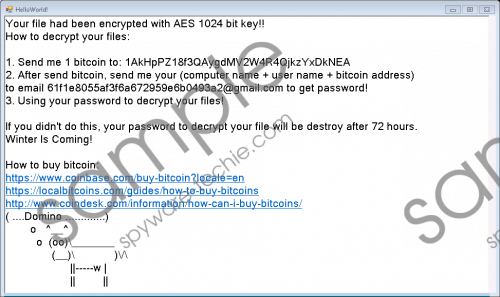Do you know what Domino Ransomware is?
Domino Ransomware is the newest threat to integrate into the large family of ransomware infections. It seems as if lately we are only reporting ransomware threats, but that is because every malicious cyber criminal has turned to attacking users with their file-encrypting threats. In fact, even less experienced and knowledgeable cyber crooks can deploy ransomware because they can be created using the source codes of the more popular threats. Overall, ransomware infections are wildly successful because they target what is the most valuable to users – their personal files. Once documents, photographs, videos, and other personal files are encrypted, their owners are backed into a corner and forced into paying a ransom. So, should you pay this ransom or maybe there is a way to circumvent it? Maybe you should just delete Domino Ransomware? Continue reading, and you will find out. Domino Ransomware screenshot
Domino Ransomware screenshot
Scroll down for full removal instructions
According to our analysis, Domino Ransomware will enter your PC via a spam email attachment. The worst part is that you will not realize that you have let in a malicious ransomware when you do. Do you remember how the file was named and where you have downloaded it? It is important to know this if you choose to remove Domino Ransomware manually. Once executed, this threat encrypts your files, and, according to the information provided via Help.exe and Helloworld.exe files, this is done using the AES 1024 algorithm. These two executable files are downloaded by the ransomware itself, and they are located in the %TEMP% directory. When the encryption of the files is completed, these files are launched to open a window with a message from cyber criminals. There is only one purpose for this message, and that is to convince you to pay a huge ransom fee. Here is an extract.
Your file had been encrypted with AES 1024 bit key!!
How to decrypt your files:
1. Send me 1 bitcoin to: [Bitcoin address]
Are you familiar with the Bitcoin currency? If you are not, you might have no clue how much 1 BTC is. Notably, this currency is extremely unstable, and the conversion rates shift constantly, but, at the moment, it converts to $575. Although there are many ransomware infections that demand much larger sums (e.g., Mahasaraswati Ransomware), 1 BTC is still a lot, and not all victims of the malicious Domino Ransomware will be able to pay it. Well, even if you have all the money in the world, you might want to reconsider paying it. The cyber criminals behind ransomware have been proven to be unreliable time and time again. All you need to do is check forums where the victims of ransomware are discussing their experiences to learn that not all of them are provided with the promised decryption tools after paying the ransoms. Does this mean that you will definitely not get the ransom key if you pay the money you are asked? We cannot claim that, but we have to warn you about this risk.
Can you remove Domino Ransomware manually? It is most likely that you can, but you need to know where all files of this threat are located. If you can identify the main executable, you are halfway through the removal process. Additionally, you need to erase the files that represent the pop-up ransom note. Of course, it would not be surprising to find that your operating system is infected with other threats, in which case, the manual removal is not ideal. Have you considered installing anti-malware software? If you have not, you should because only this software can clean your PC from all threats and, at the same time, protect it from incoming threats.
Remove Domino Ransomware
- Identify the malicious .exe file (the one you downloaded) and right-click it.
- Select Delete to get rid of it.
- Simultaneously tap Win+E to access Explorer.
- Type %temp% into the address bar and tap Enter.
- Right-click and Delete the file named Help.exe.
- Right-click and Delete the file named Helloworld.exe.
- Empty the Recycle Bin.
- Install a trusted malware scanner to inspect your operating system for leftovers.
In non-techie terms:
There is no time to waste when then Domino Ransomware attacks. Unfortunately, this threat performs its malicious activity right as it is executed. The main task for this threat is to encrypt your personal files, and, after that, it is unlikely to cause any more trouble. If your files are not backed up – and that is what the creators of this ransomware are relying on – you might see no other option but paying the ransom that is requested in return of a password that supposedly would unlock your files. Unfortunately, there are absolutely no guarantees that this password would be provided, which is why paying the ransom is considered risky. In the end, you need to remove the ransomware, and, although it is possible to erase it manually, we suggest implementing anti-malware software to reinforce Windows protection as well.
